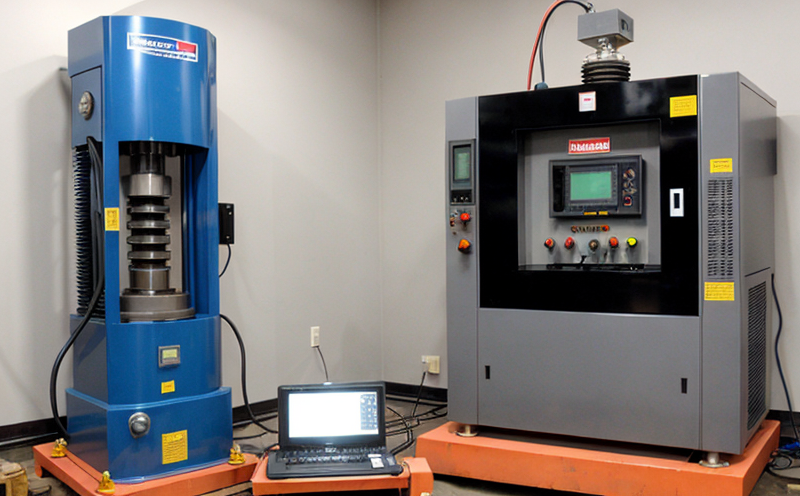ASTM D5277 Drop and Shock Testing for Shipping Containers
The ASTM D5277 drop and shock testing method is a critical procedure used to evaluate the durability of shipping containers, especially in harsh environments. This test assesses the ability of these containers to withstand sudden impacts and vibrations that they might encounter during transportation. The primary purpose is to ensure that products within the containers are protected from damage due to rough handling or adverse conditions.
The application of ASTM D5277 testing goes beyond mere compliance; it provides valuable insights into how well the container design can handle real-world stressors. This is particularly important for industries such as pharmaceuticals, electronics, and consumer goods, where product integrity must be maintained throughout distribution channels.
During the test, containers are subjected to controlled drops from various heights using a specified apparatus. The impact force generated during these drops simulates the kind of shock that might occur in transit. Additionally, the container is placed on a vibration table to simulate road and sea travel conditions. These tests help identify potential weaknesses in the design or construction materials.
The results of ASTM D5277 testing are crucial for quality assurance teams who need to ensure their products meet both internal standards as well as regulatory requirements set by organizations like ASTM International. Compliance with such standards enhances customer trust and can significantly boost market reputation.
Understanding the test parameters is essential for effective preparation and interpretation of results. Specimens used in this testing are typically full-scale shipping containers or mock-ups that replicate real-world configurations. Proper specimen preparation includes ensuring all components (such as latches, locks) are present to simulate actual use conditions accurately.
The apparatus employed during ASTM D5277 tests must adhere strictly to the specifications outlined in the standard document. This ensures consistent and reliable results across different laboratories performing similar tests. Commonly used equipment includes impact test machines capable of generating specific drop heights, vibration tables able to produce controlled frequencies, and data acquisition systems for recording all relevant parameters.
Acceptance criteria play a vital role in determining whether a container passes or fails the ASTM D5277 test. These criteria vary depending on factors like material composition, size of the container, intended use, etc., but generally focus on structural integrity, leakage prevention, and overall stability after being subjected to both drop impacts and vibrations.
By leveraging ASTM D5277 testing methods, manufacturers gain a competitive edge by producing more resilient shipping containers that better protect valuable cargo during transport. This not only reduces costs associated with product damage but also contributes positively towards sustainability goals by minimizing waste due to failed products reaching their destination intact.
Scope and Methodology
| Parameter | Description |
|---|---|
| Test Specimens | Full-scale or scaled-down mock-ups of shipping containers. |
| Drop Heights | Varying heights depending on container size and material type, typically between 1 meter to 2 meters for most applications. |
| Impact Forces | Calculated based on the mass of the container and the height from which it is dropped. |
| Vibration Frequencies | Simulated road and sea travel conditions, usually ranging from 0 Hz to 50 Hz. |
| Data Acquisition Systems | Used for recording all relevant parameters during testing. |
| Acceptance Criteria | Description |
|---|---|
| No Visible Damage | The container should not show any visible signs of damage after the test. |
| Structural Integrity | All structural elements must retain their intended shape and function post-testing. |
| Liquid Seal Integrity | If containers are designed to hold liquids, there should be no leakage detected. |
| Operational Stability | The container should remain stable during the entire testing process without significant deformation or failure. |
Why Choose This Test
Selecting ASTM D5277 drop and shock testing for shipping containers offers numerous advantages. Firstly, it provides a robust assessment of the container's ability to withstand real-world stresses encountered during transportation. Secondly, compliance with this standard can enhance your product’s reputation among customers who prioritize quality and reliability.
By incorporating ASTM D5277 into your product development process, you ensure that potential flaws are identified early on in the design phase rather than later when they could be more costly to rectify. This proactive approach also helps maintain consistency across batches produced by different manufacturers or suppliers.
The test results generated from ASTM D5277 can serve multiple purposes beyond just meeting regulatory requirements. They offer valuable feedback for continuous improvement initiatives aimed at enhancing product performance and durability over time. Additionally, these tests contribute positively towards sustainability efforts by reducing waste caused by failed products reaching their destinations intact.
Furthermore, choosing ASTM D5277 testing demonstrates a commitment to excellence in manufacturing practices which resonates well with stakeholders across various sectors including logistics companies, retailers, and end consumers alike.
Competitive Advantage and Market Impact
Implementing ASTM D5277 drop and shock testing for shipping containers can provide significant competitive advantages in several ways:
- Enhanced Product Quality: Ensures that your products are protected during transportation, thereby reducing the risk of damage.
- Better Reputation: Demonstrates a commitment to quality and reliability, enhancing your brand image among customers.
- Cost Efficiency: Identifies potential issues early in the design phase, preventing costly rework later on.
- Sustainability: Minimizes waste caused by failed products reaching their destinations intact, contributing positively towards sustainability efforts.
The market impact of adopting ASTM D5277 testing is profound. It sets a benchmark for quality that other competitors aspire to meet or exceed. Companies that invest in this type of rigorous testing tend to see increased customer loyalty and trust, leading to higher sales volumes and broader market penetration.
Moreover, compliance with internationally recognized standards like ASTM D5277 can open up new markets and opportunities for growth by meeting the specific needs of various industries such as pharmaceuticals, electronics, and consumer goods. It also facilitates smoother interactions between suppliers and buyers, fostering stronger relationships based on mutual respect and shared goals.





